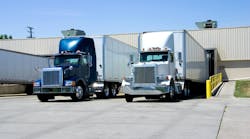How nuclear verdicts are driving up fleet insurance costs and reshaping risk strategies
Key takeaways
- Rising nuclear verdicts are driving up insurance premiums and legal costs, straining already thin fleet profit margins.
- Fleets are adopting ADAS and AI dashcams to reduce crashes, provide legal protection, and lower insurance expenses.
- Delaying fleet modernization amid inflation and tariff risks could lead to higher future costs and lost competitive ground.
Over the past decade, trucking companies have faced a growing concern: nuclear verdicts, or judgments exceeding $10 million in civil suits related to crashes. Insurance premiums and legal costs rise as a result, and these issues are spreading like a mushroom cloud at a time when fleets need to keep costs down as economic factors such as inflation and tariffs threaten to increase equipment and parts prices.
Commercial auto liabilities have experienced an annual growth of 10.1% since 2016, according to David McKnight, a principal at consulting firm The Brattle Group. He said this is the most significant increase in insurance segments tracked in his company’s Tort Costs in America study.
The rising cost of justice: How nuclear verdicts are reshaping trucking’s risk landscape
McKnight’s research indicates that costs and compensation related to the U.S. tort system totaled $529 billion in 2022, accounting for more than 2% of the U.S. GDP. And 11%, or $58 billion, was related to commercial vehicles.
“Nobody can deny the fact that our industry is targeted,” asserted Drew Hofley, VP of sales at Phillips Industries. “For every dollar of revenue that [trucking companies] make, 90 cents of it goes to cover their costs,” he noted. They now must self-insure, shaving their razor-thin profit margins even more.”
He mentioned a particular personal injury lawyer in Dallas who brags on billboards that he earned a client $27 million for injuries he suffered in a truck accident. The lawyer’s fee: $21 million.
“Anybody who says it’s not inflationary is delusional,” Hofley added.
From 2022 to 2023, the number of nuclear verdicts overall in the U.S. rose to 89, a 27% year-over-year increase, Marathon Strategies reported in its Corporate Verdicts Go Thermonuclear report. The median award was $44 million, though the number of thermonuclear verdicts—those above $100 million—is on the rise. Marathon said these grew by 35% in 2023. Juries from Missouri ($4 billion) and Texas ($3.7 billion) gave out the most nuclear verdicts overall across several industries.
In Missouri, a jury levied $450 million in punitive damages against Wabash because an intoxicated driver sped directly into a nearly stopped 15-year-old trailer’s backend and died, as did his passenger. Judge Christopher McGraugh decided that it was “grossly excessive” and lowered it to $108 million, with additional Wabash appeals still pending. Texas, meanwhile, can claim the $100 million verdict against Werner Enterprises and a $160 million decision against Daimler Truck North America.
A system stacked against fleets and manufacturers
This report noted Florida dropped from second place to seventh after tort reforms were signed into law by Gov. Ron DeSantis.
That’s not even scratching the surface of the complicated issues that have created an environment where nine-figure nuclear verdicts are no longer surprising—and which are leading to unsustainable trucking insurance rates.
The Wabash case, in particular, raised many concerns for fleets: What does it mean for fleets still operating older trailers (or trailers with rear-impact guards [RIG] spec’d to meet National Highway Traffic Safety Administration standards when stronger upgrades are available)? What does it mean for trailer OEMs that might wonder what the point of federal safety standards is if a jury can come back years later and decide you should have exceeded regulations?
The facts of the case can make any fleet feel like the system is rigged against the trucking industry:
In 2019, two young men, a father and a father-to-be, died in an accident when the Volkswagen sedan they were in crashed at highway speed into the rear of a tractor-trailer that had slowed to a near stop in a construction zone. A toxicology report revealed the driver was intoxicated; a separate police report indicated that neither sedan occupant was wearing a seat belt, according to a filing by the carrier involved, GDS Express, which has since lost its operating authority, according to the Federal Motor Carrier Safety Administration.
Attorneys representing the surviving family members argued that a stronger RIG could have saved the lives of both the driver and passenger. They contended that Wabash, the manufacturer, used a design that met only the minimum federal requirements in 2004, rather than implementing a more robust RIG.
Wabash contended that the collision severity was “far in excess” of that contemplated by the RIG regulations and that the plaintiff’s case—which focused on a RIG design from a decade later—punished Wabash for “current conduct” rather than the conduct related to the accident, a violation of Missouri procedure and even a violation of Wabash’s Constitutional rights, as the company argued in a motion for a partial summary judgment.
For fleets and equipment manufacturers, is this jury award an anomaly, or does it represent a trend of judgments lacking a realistic basis? What are Wabash's appeal options and arguments moving forward? How can fleets and equipment manufacturers better safeguard themselves? How can a company mount a defense without appearing insensitive to accident victims? When will this cycle conclude?
Taking on the nuclear threats
With the proliferation of nuclear verdicts, fleets cannot wait for other states to reform their tort law, and they certainly cannot “duck and cover,” the recommended practice for actual nuclear explosions. They must face the threat head-on. And while plaintiff lawyers emotionally manipulate juries to achieve their lucrative payouts, fleets have found technology to strike back.
In the cab itself, this means advanced driver assistance systems (ADAS), including collision mitigation, lane keep assist, and blind-spot monitoring. These are always active and provide surface-level protection. Fleets can go deeper with AI-enhanced dashcams, available with options for forward, inward, or both facing directions, as well as trailer compatibility. In the event of an accident, they can provide video evidence that may exonerate a fleet. Preventively, they act as in-cab coaches giving real-time alerts if a driver is speeding (via an accelerometer) or engaging in behavior that could distract them.
Video can also be sent to management for review of specific unsafe practices, allowing for more in-depth coaching. In addition, positive and negative events can be used to train other drivers. Some may show how a fleet’s star driver turned certain doom into a near miss, while another can show how a momentary lapse in judgment can create a fatality.
Advanced driver assistance systems offer a powerful dual benefit, according to Brian Holland, president and CEO of Fleet Advantage. They enhance safety by mitigating human error and simultaneously drive down operational costs. ADAS can reduce collisions by a significant margin, with some reporting a 47% reduction since its widespread adoption. Furthermore, adaptive cruise control and predictive gear shifting enhance vehicle performance and fuel consumption, resulting in improved fleet fuel efficiency and lower emissions.
“Investing in these technologies is not just about compliance,” Holland said. “It’s about creating a safer working environment for drivers, protecting valuable cargo, and safeguarding the company's reputation, all while securing a powerful return on investment through reduced accident costs, lower insurance premiums, and substantial fuel savings.”
To help keep future costs down, fleets should look at what they can invest in today, Holland added.
“Because of persistent tariff threats and inflationary pressures, the longer companies hesitate, the more likely it is that they will pay more tomorrow,” he explained. “Accelerating fleet modernization is not just about avoiding future costs; it's about seizing the opportunity to gain a competitive edge today, ensuring operational resilience, and fulfilling the core responsibility of delivering products efficiently, safely, and fiscally responsibly. The cost of inaction is too high to bear.”
About the Author
John Hitch
Editor
John Hitch is the editor-in-chief of Fleet Maintenance, providing maintenance management and technicians with the the latest information on the tools and strategies to keep their fleets' commercial vehicles moving. He is based out of Cleveland, Ohio, and was previously senior editor for FleetOwner. He previously wrote about manufacturing and advanced technology for IndustryWeek and New Equipment Digest.
Kevin Jones
Editor
Kevin has served as editor-in-chief of Trailer/Body Builders magazine since 2017—just the third editor in the magazine’s 60 years. He is also editorial director for Endeavor Business Media’s Commercial Vehicle group, which includes FleetOwner, Bulk Transporter, Refrigerated Transporter, American Trucker, and Fleet Maintenance magazines and websites.
Working from Beaufort, S.C., Kevin has covered trucking and manufacturing for nearly 20 years. His writing and commentary about the trucking industry and, previously, business and government, has been recognized with numerous state, regional, and national journalism awards.






